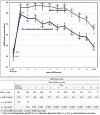Physical activity and renal function in the Italian kidney transplant population
- PMID: 33256487
- PMCID: PMC7717861
- DOI: 10.1080/0886022X.2020.1847723
Physical activity and renal function in the Italian kidney transplant population
Abstract
Background: The well-documented benefits of physical activity (PA) are still poorly characterized in long-term kidney transplant outcome. This study analyzed the impact over a 10-year follow-up of PA on graft function in Italian kidney transplant recipients (KTRs).
Methods: Since 2002, the Italian Transplant-Information-System collected donor and recipient baseline and transplant-related parameters in KTRs. In 2015, 'penchant for PA' (PA ≥ 30-min, 5 times/week) was added. Stable patients aged ≥18 years at the time of first-transplantation were eligible. KTRs with at least 10-year follow-up were also analyzed. Mixed-effect regression models were used to compare eGFR changes over time in active versus non-active patients.
Results: PA information was available for 6,055 KTRs (active 51.6%, non-active 48.4%). Lower penchant for PA was found in overweight and obese patients (OR = 0.84; OR = 0.48, respectively), in those with longer dialysis vintage (OR = 0.98 every year of dialysis), and older age at transplant. Male subjects showed greater penchant for PA (OR = 1.25). A slower decline of eGFR over time was observed in active KTRs compared to non-active, and this finding was confirmed in the subgroup with at least 10-year follow-up (n = 2,060). After applying the propensity score matching to reduce confounding factors, mixed-effect regression models corroborated such better long-term trend of graft function preservation in active KTRs.
Conclusions: Penchant for PA is more frequent among male and younger KTRs. Moreover, in our group of Italian KTRs, active patients revealed higher eGFR values and preserved kidney function over time, up to 10-years of follow-up.
Keywords: eGFR; exercise; kidney transplant recipients; mixed-regression-analysis; physical activity; propensity score match; renal function; sedentary lifestyle.
Conflict of interest statement
No potential conflict of interest was reported by the author(s).
Figures




Similar articles
-
Higher mortality risk among kidney transplant recipients than among estimated glomerular filtration rate-matched patients with CKD-preliminary results.Nephrol Dial Transplant. 2021 Jan 1;36(1):176-184. doi: 10.1093/ndt/gfaa026. Nephrol Dial Transplant. 2021. PMID: 32162656
-
Longitudinal Analysis of Cardiovascular Risk Factors in Active and Sedentary Kidney Transplant Recipients.Medicina (Kaunas). 2020 Apr 16;56(4):183. doi: 10.3390/medicina56040183. Medicina (Kaunas). 2020. PMID: 32316125 Free PMC article.
-
Blood Pressure, Chronic Kidney Disease Progression, and Kidney Allograft Failure in Kidney Transplant Recipients: A Secondary Analysis of the FAVORIT Trial.Am J Hypertens. 2019 Aug 14;32(9):816-823. doi: 10.1093/ajh/hpz095. Am J Hypertens. 2019. PMID: 31179500 Free PMC article.
-
Mapping health-related quality of life after kidney transplantation by group comparisons: a systematic review.Nephrol Dial Transplant. 2021 Dec 2;36(12):2327-2339. doi: 10.1093/ndt/gfab232. Nephrol Dial Transplant. 2021. PMID: 34338799 Free PMC article.
-
Current Evidence on Dietary Factors and Kidney Allograft Function in Kidney Transplant Recipients: A Systematic Review.Curr Med Chem. 2024;31(35):5818-5836. doi: 10.2174/0929867330666230515140454. Curr Med Chem. 2024. PMID: 37190815
Cited by
-
Pretransplant Physical Activity and Cardiovascular Risk Factors in Kidney Transplant Candidates: A Cross-Sectional Study.Healthcare (Basel). 2025 May 20;13(10):1200. doi: 10.3390/healthcare13101200. Healthcare (Basel). 2025. PMID: 40428036 Free PMC article.
-
Cognitive impairment in kidney transplanted patients.Nephrol Dial Transplant. 2025 Mar 13;40(Supplement_2):ii46-ii53. doi: 10.1093/ndt/gfae250. Nephrol Dial Transplant. 2025. PMID: 40080090 Free PMC article. Review.
-
Physical Inactivity: A Modifiable Risk Factor for Morbidity and Mortality in Kidney Transplantation.J Pers Med. 2021 Sep 18;11(9):927. doi: 10.3390/jpm11090927. J Pers Med. 2021. PMID: 34575704 Free PMC article. Review.
-
Physical Activity Levels in Transplant Recipients.Ann Transplant. 2024 Jun 11;29:e944101. doi: 10.12659/AOT.944101. Ann Transplant. 2024. PMID: 38859567 Free PMC article.
-
Supervised vs home-based exercise program in kidney transplant recipients: A pilot pragmatic non-randomized study.World J Transplant. 2024 Dec 18;14(4):96244. doi: 10.5500/wjt.v14.i4.96244. World J Transplant. 2024. PMID: 39697462 Free PMC article.
References
-
- Cannon CP. Cardiovascular disease and modifiable cardiometabolic risk factors. Clin Cornerstone. 2007;8(3):11–28. - PubMed
-
- Heiwe S, Jacobson SH.. Exercise training in adults with CKD: a systematic review and meta-analysis. Am J Kidney Dis. 2014;64(3):383–393. - PubMed
-
- Zelle DM, Klaassen G, van Adrichem E, et al. . Physical inactivity: a risk factor and target for intervention in renal care. Nat Rev Nephrol. 2017;13(5):318. - PubMed
-
- Greenwood SA, Koufaki P, Mercer TH, et al. . Effect of exercise training on estimated gfr, vascular health, and cardiorespiratory fitness in patients with CKD: a pilot randomized controlled trial. Am J Kidney Dis. 2015;65(3):425–434. - PubMed
MeSH terms
LinkOut - more resources
Full Text Sources
Other Literature Sources
Medical
Research Materials
Miscellaneous
